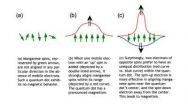(Press-News.org) BOSTON--Researchers at Dana-Farber Cancer Institute have demonstrated a molecular strategy they say could make a much larger variety of tumors treatable with PARP inhibitors, a promising new class of cancer drugs.
Currently, the role of PARP inhibitors has mainly been restricted to cancers whose cells lack functioning versions of the damage-repair proteins BRCA1 or BRCA2 -- chiefly certain breast and ovarian cancers.
In a paper published online by Nature Medicine, Geoffrey Shapiro, MD, and colleagues report that the BRCA1 repair protein is dependent on another protein, CDK1, known primarily as a regulator of the cell division cycle. When the scientists blocked CDK1 in cancer cell lines and in a mouse model of lung cancer, BRCA1 function was disrupted, making them susceptible to being killed by a PARP inhibitor.
Because most types of tumors don't have a mutated BRCA1 protein, they are less likely to be affected by PARP inhibitor treatment. The new findings, said Shapiro, "suggest that by blocking CDK1, we can disable BRCA1 in many types of cancers and make them sensitive to a PARP inhibitor. It could extend the use of these drugs to a much larger group of patients."
Shapiro, who heads Dana-Farber's Early Drug Development Center, said a clinical trial combining a CDK1 blocker and a PARP inhibitor in a variety of solid tumors is being planned.
Cells are equipped to heal damage to their DNA strands, which are constantly being nicked or broken by exposure to environmental contaminants or randomly during cell division. Cancer cells, in addition, become adept at repairing potentially lethal DNA damage caused by radiation and chemotherapy drugs, and use their DNA repair machinery to survive and grow uncontrollably.
A major thrust in cancer research currently is developing ways to disable tumor cells' repair toolkits to make them more vulnerable to DNA-damaging agents. PARP inhibitor drugs prevent tumor cells from repairing less-serious damage to the DNA strands of cancer cells; if those cells happen to lack a normal BRCA protein, the damage becomes more serious and the cells can't repair it, and then the cells die.
Most types of cancer cells, however, have normal BRCA proteins, making PARP inhibitors less effective. The Dana-Farber scientists sought a way to get around this and convert "BRCA-competent" tumor cells to "BRCA-less" cells that would be sensitive to anti-PARP drugs. Their studies revealed that BRCA1 molecules depend on the cell-cycle protein CDK1 to activate them.
CDK1 was previously identified as a regulator of the cell division cycle that can be overactive in many types of cancers, leading to unchecked growth. Currently several CDK1 inhibitors are in clinical trials as potential weapons against cancer. Shapiro and his colleagues implicated CDK1 for the first time as a control point in the DNA repair circuit that contains BRCA1. This suggested that blocking CDK1 activity might prevent BRCA1 from rescuing cancer cells from life-threatening DNA damage.
In a study involving lung cancer cells in the laboratory and implanted in mice, the researchers "found that if we deplete cancer cells of CDK1, we disrupt DNA repair and the cells become very sensitive to PARP inhibitors," said Shapiro, the senior author of the report. The researchers obtained their results using an existing CDK1- blocking drug along with a PARP inhibitor.
As a more stringent test, they tried the same strategy in mice genetically engineered with an oncogene, KRAS, that drives the most aggressive lung cancers in humans.
"We achieved tremendous responses in this mouse model," Shapiro said. "The survival curve of the animals nearly doubled."
In addition, he said, his team collaborated with pathologists at Brigham and Women's Hospital to show that the CDK1-PARP inhibiting strategy is selective for cancer cells -- normal cells were unaffected. Accordingly, Shapiro said, they did not observe significant toxicity from the drug treatment.
"We're quite excited about this and looking forward to evaluating this combination in clinical trials," said Shapiro.
INFORMATION:
The first author of the report is Neil Johnson, PhD. Other authors include Kwok-Kin Wong, MD, PhD, and Alan D'Andrea, MD, of Dana-Farber and researchers from Brigham and Women's Hospital, Harvard Medical School Children's Hospital Boston, and the University of New Castle, Newcastle Upon Tyne UK.
The research was supported by grants from the National Institutes of Health.
Dana-Farber Cancer Institute (www.dana-farber.org) is a principal teaching affiliate of the Harvard Medical School and is among the leading cancer research and care centers in the United States. It is a founding member of the Dana-Farber/Harvard Cancer Center (DF/HCC), designated a comprehensive cancer center by the National Cancer Institute. It provides adult cancer care with Brigham and Women's Hospital as Dana-Farber/Brigham and Women's Cancer Center and it provides pediatric care with Children's Hospital Boston as Dana-Farber/Children's Hospital Cancer Center. Dana-Farber is the top ranked cancer center in New England, according to U.S. News & World Report, and one of the largest recipients among independent hospitals of National Cancer Institute and National Institutes of Health grant funding.
Blocking molecular target could make more cancers treatable with PARP inhibitors
2011-06-30
ELSE PRESS RELEASES FROM THIS DATE:
Warrantless Cell Phones Searches Raise Serious Constitutional Concerns
2011-06-30
As technologies develop at an exponential pace, courts across the country are left scrambling to address the issues they create. The world we live in is becoming smaller and smaller as social media and smart phones provide more and more information about users' personal lives. Invariably, judges and members of law enforcement are forced to confront the privacy concerns these platforms generate.
Specifically, courts all across the United States are in the midst of resolving the issue of whether searching cell phones without a warrant during an arrest infringes on individuals' ...
UT MD Anderson debuts lung cancer screening program
2011-06-30
HOUSTON - Current and former heavy smokers can now be screened more effectively for lung cancer. Results from the National Lung Screening Trial (NLST) revealed that detecting small lung cancers with computed tomography (CT) reduces lung cancer specific mortality by 20 percent.
Prior to the trial, lung cancer, often diagnosed in the later stages of the disease, had shown no benefit from screening because screening with standard chest X-rays did not detect cancers early enough. The trial, funded by the National Cancer Institute (NCI), is the driving force behind a new ...
Money and mimicry
2011-06-30
"Money, money, money
Must be funny
Money, money, money
Always sunny
In the rich man's world."
-ABBA, 1976
We rely on money in our day-to-day life and it is constantly in our minds. After all, money makes the world go round, doesn't it? Now, a new study, which will be published in an upcoming issue of Psychological Science, a journal of the Association for Psychological Science, tries to better understand the psychological effect of money and how it affects our behavior, feelings and emotions.
Jia Liu, at the University of Groningen, co-wrote the article along with ...
The Push for Honorable Discharge Status for Those Expelled Under "Don't Ask, Don't Tell"
2011-06-30
For years, homosexuality was grounds for discharge from the armed services of the United States. In 1993, President Clinton initiated the controversial "don't ask, don't tell" ("DADT") policy as a compromise that required gay soldiers to be discreet about their sexuality or face being thrown out of the military. DADT ruled the military policy on homosexuality for 17 years.
But, on December 22, President Obama signed into law a bill that will allow gay men and women to serve openly in uniform for the first time in U.S. History. After certification ...
At small scales, tug-of-war between electrons can lead to magnetism
2011-06-30
BUFFALO, N.Y. -- At the smallest scales, magnetism may not work quite the way scientists expected, according to a recent paper in Physical Review Letters by Rafał Oszwałdowski and Igor Žutić of the University at Buffalo and Andre Petukhov of the South Dakota School of Mines and Technology.
The three physicists have proposed that it would be possible to create a quantum dot -- a kind of nanoparticle -- that is magnetic under surprising circumstances.
Magnetism is determined by a property all electrons possess: spin. Individual spins are akin to tiny bar ...
Four Attorneys from Albany-Area Law Firm Selected for New York Super Lawyers List
2011-06-30
Four attorneys from Hacker Murphy, LLP, in Latham, NY, have been selected for inclusion in 2011 New York Super Lawyers. The four attorneys are James E. Hacker, David R. Murphy, John F. Harwick and Mark R. Sonders.
The Super Lawyers selections are based on an annual process in given jurisdictions. Only five percent of the lawyers in each jurisdiction are typically selected.
Three of the four Hacker Murphy attorneys selected this year for the New York Super Lawyers list have been selected before. James E. Hacker was selected from 2006 to 2009. David R. Murphy and Mark ...
Immigration Law Review Article Written by Houston Attorney Benny Agosto Jr. Has Appeared In Several Publications
2011-06-30
Houston personal injury attorney Benny Agosto Jr. of Abraham, Watkins, Nichols, Sorrels, Agosto & Friend is receiving nationwide recognition once again.
While attorney Benny Agosto is often recognized for his dedication to the Houston community and the legal profession, this time he is being singled out for his work on the widely published immigration article "But Your Honor, He's an Illegal! Can the Undocumented Worker's Alien Status Be Introduced at Trial?"
Co-authored with Texas Southern University Law Prof. Lupe Salinas and Texas attorney Eloisa ...
New therapy for childhood neuroblastoma proves feasible and safe
2011-06-30
Reston, Va. (June 29, 2011) – A new treatment option may soon be available for children with neuroblastoma according to research published in the July issue of The Journal of Nuclear Medicine. The study tested the principle that combined positron emission tomography and X-ray computed tomography (PET/CT) may be used to select children with primary refractory or relapsed high-risk neuroblastoma for treatment with a molecular radiotherapy known as 177Lu-DOTATATE. This therapeutic option was found to be viable option for children with neuroblastomas.
Neuroblastoma is a ...
Shortening time between CPR and shocks improves cardiac-arrest survival
2011-06-30
DALLAS – June 29, 2011 – Reducing the intervals between giving cardiopulmonary resuscitation (CPR) and an electronic defibrillator shock after cardiac arrest significantly improves survival, according to UT Southwestern Medical Center emergency medicine doctors involved in an international study.
Chest compressions applied within 10 seconds before the defibrillator shocks and within 20 seconds after the shock boosted survival chances by more than half compared to the rates for people who received chest compressions more than 20 seconds before or 40 seconds after the shock, ...
UBC researchers invent new drug delivery device to treat diabetes-related vision loss
2011-06-30
A team of engineers and scientists at the University of British Columbia has developed a device that can be implanted behind the eye for controlled and on-demand release of drugs to treat retinal damage caused by diabetes.
Diabetic retinopathy is the leading cause of vision loss among patients with diabetes. The disease is caused by the unwanted growth of capillary cells in the retina, which in its advanced stages can result in blindness.
The novel drug delivery mechanism is detailed in the current issue of Lab on a Chip, a multidisciplinary journal on innovative microfluidic ...



